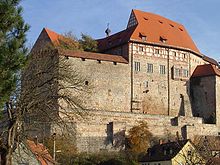Cadolzburg District Court
The Cadolzburg Regional Court was an older Bavarian regional court that existed from 1808 to 1879 and was based in Cadolzburg in what is today the Fürth district . In the Kingdom of Bavaria , the regional courts were judicial and administrative authorities, which were replaced in administrative matters by the district offices in 1862 and in legal matters by the local courts in 1879 . The district court was housed in Cadolzburg Castle.
location
The district court Cadolzburg bordered on the southwest by the district court Heilsbronn , on the west by the district court Erlbach , to the north by the district court of Herzogenaurach , in the north and east by the district court of Erlangen and the south by the district court Schwabach .
structure
Tax districts
In 1808 the Cadolzburg district court was established in the course of the administrative restructuring of Bavaria . This initially belonged to the Pegnitzkreis and from 1810 to the Rezatkreis . In 1808 19 tax districts were formed:
Rural communities
In 1808 the rural communities arose , which were initially congruent with the tax districts. With the second community edict (1818), the rural communities received more powers. At the same time, some of the previously existing rural communities were split up. This gave the following 27 rural communities:
|
|
On September 16, 1836, the Burgstall community was handed over to the Herzogenaurach Regional Court . On October 1, 1842, Wilhermsdorf was handed over to the Markt Erlbach district court .
In 1840 the Cadolzburg district court was 4½ square miles. There were 13,537 inhabitants, of whom 13,436 were Protestants, 49 Catholics and 72 Jews. There were 104 localities: 1 town, 3 markets, 6 parish villages, 8 church villages, 24 villages, 31 hamlets and 31 wastelands. There were a total of 25 municipalities: 1 Magistrate III. Class, and 24 rural parishes.
See also
literature
- Address manual for the Rezat district of the Kingdom of Baiern . Johann Baptist Reindl, Bamberg 1814, p. 10–11 ( digitized version ).
- Address and statistical handbook for the Rezatkreis in the Kingdom of Baiern . Buchdruckerei Chancellery, Ansbach 1820, p. 27-28 ( digitized version ).
- Hanns Hubert Hofmann : Nuremberg-Fürth (= Historical Atlas of Bavaria, part Franconia I, 4). Commission for Bavarian State History, Munich 1954, DNB 452071224 ( digitized version ).
- Karl Friedrich Hohn: The Retzatkreis of the Kingdom of Bavaria described geographically, statistically and historically . Riegel and Wießner, Nuremberg 1829, p. 190-198 ( digitized version ).
- Circle of Bavarian Scholars (Ed.): Upper Franconia and Middle Franconia (= Bavaria. Regional and Folklore of the Kingdom of Bavaria . Volume 3 ). Literary and artistic establishment of the JG Cotta'schen Buchhandlung, Munich 1865, DNB 56034290X , p. 1238-1240 ( digitized version ).
- Pleikard Joseph Stumpf : Cadolzburg district court . In: Bavaria: a geographical-statistical-historical handbook of the kingdom; for the Bavarian people . Second part. Munich 1853, p. 698-701 ( digitized version ).
- Eduard Vetter (Hrsg.): Statistical handbook and address book of Middle Franconia in the Kingdom of Bavaria . Self-published, Ansbach 1846, p. 64-70 ( digitized version ).
- Eduard Vetter (Hrsg.): Statistical handbook and address book of Middle Franconia in the Kingdom of Bavaria . Brügel'sche Officin, Ansbach 1856, p. 75-82 ( digitized version ).
- Wilhelm Volkert (Hrsg.): Handbook of the Bavarian offices, communities and courts 1799–1980 . CH Beck, Munich 1983, ISBN 3-406-09669-7 , p. 467 .
Individual evidence
- ↑ E. Vetter (1846), p. 64.
